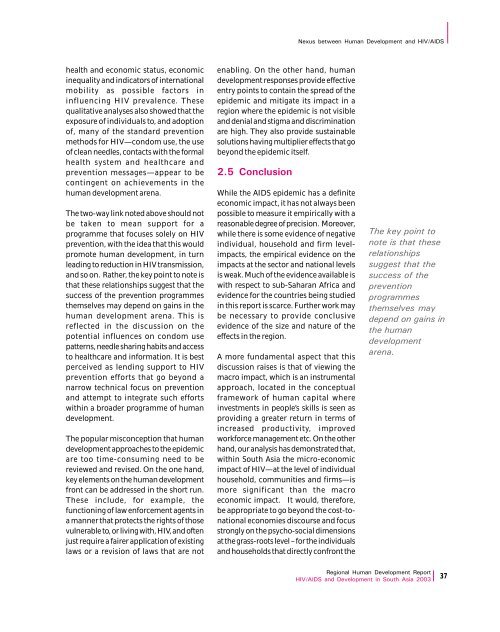Download Report - UNDP Asia-Pacific Regional Centre - United ...
Download Report - UNDP Asia-Pacific Regional Centre - United ...
Download Report - UNDP Asia-Pacific Regional Centre - United ...
You also want an ePaper? Increase the reach of your titles
YUMPU automatically turns print PDFs into web optimized ePapers that Google loves.
Nexus between Human Development and HIV/AIDShealth and economic status, economicinequality and indicators of internationalmobility as possible factors ininfluencing HIV prevalence. Thesequalitative analyses also showed that theexposure of individuals to, and adoptionof, many of the standard preventionmethods for HIV—condom use, the useof clean needles, contacts with the formalhealth system and healthcare andprevention messages—appear to becontingent on achievements in thehuman development arena.The two-way link noted above should notbe taken to mean support for aprogramme that focuses solely on HIVprevention, with the idea that this wouldpromote human development, in turnleading to reduction in HIV transmission,and so on. Rather, the key point to note isthat these relationships suggest that thesuccess of the prevention programmesthemselves may depend on gains in thehuman development arena. This isreflected in the discussion on thepotential influences on condom usepatterns, needle sharing habits and accessto healthcare and information. It is bestperceived as lending support to HIVprevention efforts that go beyond anarrow technical focus on preventionand attempt to integrate such effortswithin a broader programme of humandevelopment.The popular misconception that humandevelopment approaches to the epidemicare too time-consuming need to bereviewed and revised. On the one hand,key elements on the human developmentfront can be addressed in the short run.These include, for example, thefunctioning of law enforcement agents ina manner that protects the rights of thosevulnerable to, or living with, HIV, and oftenjust require a fairer application of existinglaws or a revision of laws that are notenabling. On the other hand, humandevelopment responses provide effectiveentry points to contain the spread of theepidemic and mitigate its impact in aregion where the epidemic is not visibleand denial and stigma and discriminationare high. They also provide sustainablesolutions having multiplier effects that gobeyond the epidemic itself.2.5 ConclusionWhile the AIDS epidemic has a definiteeconomic impact, it has not always beenpossible to measure it empirically with areasonable degree of precision. Moreover,while there is some evidence of negativeindividual, household and firm levelimpacts,the empirical evidence on theimpacts at the sector and national levelsis weak. Much of the evidence available iswith respect to sub-Saharan Africa andevidence for the countries being studiedin this report is scarce. Further work maybe necessary to provide conclusiveevidence of the size and nature of theeffects in the region.A more fundamental aspect that thisdiscussion raises is that of viewing themacro impact, which is an instrumentalapproach, located in the conceptualframework of human capital whereinvestments in people’s skills is seen asproviding a greater return in terms ofincreased productivity, improvedworkforce management etc. On the otherhand, our analysis has demonstrated that,within South <strong>Asia</strong> the micro-economicimpact of HIV—at the level of individualhousehold, communities and firms—ismore significant than the macroeconomic impact. It would, therefore,be appropriate to go beyond the cost-tonationaleconomies discourse and focusstrongly on the psycho-social dimensionsat the grass-roots level – for the individualsand households that directly confront theThe key point tonote is that theserelationshipssuggest that thesuccess of thepreventionprogrammesthemselves maydepend on gains inthe humandevelopmentarena.<strong>Regional</strong> Human Development <strong>Report</strong>HIV/AIDS and Development in South <strong>Asia</strong> 2003 37
















